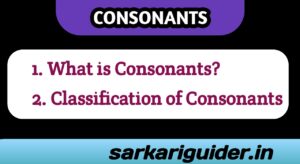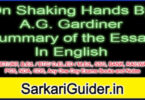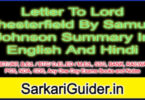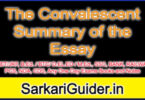what is Consonants? meaning and classification

what is Consonants?
what is Consonants?
A consonants is a letter of the alphabet which represents a sound that can only be articulated with a vowel. This may not be a complete definition because there are sibilant consonants such as ‘f’ and ‘z‘ and some laterals and nasals which can be pronounced without the help of any vowel. Thus, the best definition of a consonant is a sound which is produced by a stoppage or a partial stoppage of the breath. Consonant sounds known as contoids. In Received Pronunciation (RP), there are 24 consonants (or consonant phonemes, to be precise).
Classification of Consonants
1) Voiced and Voiceless Sound Components: The voiced sounds in English are L, b, d, g, v, z, d3, m, n, l, r, w. j/. All vocoids and semi-vowels are voiced sounds. In the case of consonants, some are voiced and some voiceless.
2) Place of Articulation: The classification of English consonants according to the place of articulation are as follows:
i) Bilabial Consonant: Whose place of articulation is the upper lip and the lower lip. Examples are /p, b, m, w/.
ii) Dental Consonant: Whose place of articulation is the teeth and the tip of the tongue.
iii) Labio-Dental Consonant: Whose place of articulation is the lower lip and the upper teeth.
iv) Alveolar Consonant: Whose place of articulation is between the alveolar (teeth) ridge and tip and blade of tongue. Examples of such consonants are /t, d, s, z, r, 1, n/.
v) Post-Alveolar Consonant: Whose place of articulation is hard palate and tip of tongue. Example of such consonant is /r/.
vi) Palato-Alveolar Consonant: Whose place of articulation is hard palate alveolar and tip, blade and front of tongue. Examples of such consonants are /f, 3, t, f, d3/.
vii) Palatal Consonant: Whose place of articulation is the hard palate and front of tongue. Example of such consonant is /j/.
viii) Velar Consonant: Whose place of articulation is the soft palate and back of tongue. Examples of such consonants are /K, g, n/.
ix) Glottal Consonant: Whose place of articulation is the glottis or the vocal cords. Example of such consonant is /h/.
3) Manner of Articulation: Consonants may be classified according to the manner of articulation as follows:
i) Plosives: The sound is produce by some forms of complete stopping of air stream and the letting it goes by sudden force. Such consonants are known as plosives. Those sounds are divided in three categories – bilabial plosive, alveolar plosive and velar plosive.
- Bilabial Plosives: For /p/, /b/, the air passage in mouth is closed by the two lips, and soft palate is raised to shut off nasal passage.
- Alveolar Plosive: For the /t/, /d/, the air passage in the mouth is closed by the tip of the tongue making a contact with the teeth ridge.
- Velar Plosive: For /k/, /g/ the air passage is closed completely by the back of tongue making contact with soft plate. The nasal passage is also closed by the soft palate. The air from the lungs is compressed. When the tongue is suddenly remove from the soft palate the air escapes with explosion. The vocal cords are wide apart for /k/, and vibrate for /g/.
ii) Affricate: The sounds that are produced by some form of complete stopping of the air stream and then letting it go slowly such sounds produce in same friction are known affricate. Like /d3/, /3/.
ill) Nasals: While articulating of such sounds, the velum is lower and the air stream is allowed to flow through the nose/nasal cavity. So, the sounds are known as nasal sounds.
- Bilabial Nasal: For /m/, the mouth passage is completely closed by the lips. The soft palate is lowered and thee air comes out through the nose the vocal cords are vibrate.
- Alveolar Nasal: For /n/, the tip of tongue make closer against the teeth ridge. The soft palate is lowered and air comes out through the nose. The vocal cords vibrate.
- Velar Nasal: For /y/, the back of tongue makes a closer with soft palate. This is lowered so that the air escapes through the nose. The vocal cords vibrate,
iv) Lateral: The air comes from lungs and passed though sides of the tongue and produces certain sounds are known as lateral. Sound like /l/.
v) Approximants / Semi-vowel: The articulation of each is strongly influenced by flowing vowel sound. So, the sounds are also called some time semi-vowels. The sounds /w/, /j/, are sometime called ‘semi-vowels’ or ‘glides’ because they are typically produce with the tongue moving or gliding to or from the position of nearby vowels both /w/, /j/, are voiced. Like we, wet, you, yes.
vi) Fricatives: The sounds that are articulated with a structure of close approximation are called fricative. The soft palate raise to shut off nasal cavity and the lung-air escapes through the narrow space between the active and the passive articulators. Following are the main fricatives:
- Labio-Dental Fricatives: For /f/, /v/ the lower lips are brought much closed to the upper teeth. The soft plate raise to shut off the nasal passage. The air comes out between the lower lip and the upper teeth with frication. The vocal cords wide apart for /f/, but vibrate for /v/.
- Dental Fricatives: the tip of tongue is brought very near and contact with upper teeth. The air passing between tip and blade of tongue and the upper teeth produce audible friction. The vocal cords wide apart for /0/, but vibrate for //.
- Alveolar fricatives: For /s/, /z/, the tip of tongue and blade of tongue brought very near to teeth ridge. The air comes out it produce audible sounds. The vocal cords are wide apart for /s/, but vibrate for /z/.
Important Links
- John Keats Biography
- Percy Bysshe Shelley Biography
- William Wordsworth as a Romantic Poet
- William Wordsworth as a poet of Nature
- William Wordsworth Biography
- William Collins Biography
- John Dryden Biography
- Alexander Pope Biography
- Metaphysical Poetry: Definition, Characteristics and John Donne as a Metaphysical Poet
- John Donne as a Metaphysical Poet
- Shakespeare’s Sonnet 116: (explained in hindi)
- What is poetry? What are its main characteristics?
- Debate- Meaning, Advantage & Limitations of Debate
- Sarojini Naidu (1879-1949) Biography, Quotes, & Poem Indian Weavers
- Charles Mackay: Poems Sympathy, summary & Quotes – Biography
- William Shakespeare – Quotes, Plays & Wife – Biography
- Ralph Waldo Emerson – Poems, Quotes & Books- Biography
- What is a lyric and what are its main forms?






